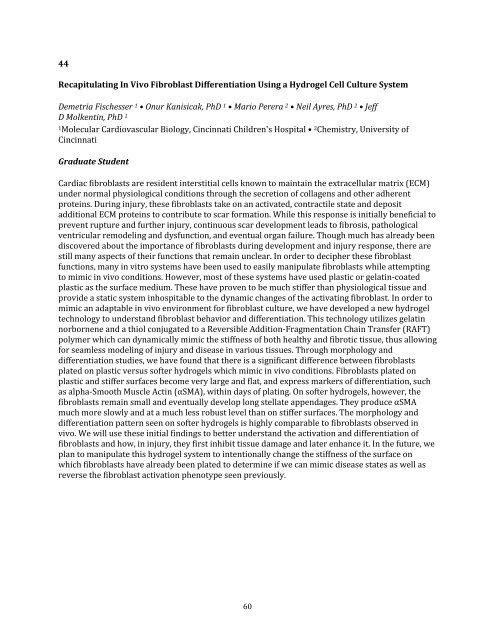2017 Cardiovascular Research Day Abstract Book
You also want an ePaper? Increase the reach of your titles
YUMPU automatically turns print PDFs into web optimized ePapers that Google loves.
44<br />
Recapitulating In Vivo Fibroblast Differentiation Using a Hydrogel Cell Culture System<br />
Demetria Fischesser 1 • Onur Kanisicak, PhD 1 • Mario Perera 2 • Neil Ayres, PhD 2 • Jeff<br />
D Molkentin, PhD 1<br />
1Molecular <strong>Cardiovascular</strong> Biology, Cincinnati Children's Hospital • 2 Chemistry, University of<br />
Cincinnati<br />
Graduate Student<br />
Cardiac fibroblasts are resident interstitial cells known to maintain the extracellular matrix (ECM)<br />
under normal physiological conditions through the secretion of collagens and other adherent<br />
proteins. During injury, these fibroblasts take on an activated, contractile state and deposit<br />
additional ECM proteins to contribute to scar formation. While this response is initially beneficial to<br />
prevent rupture and further injury, continuous scar development leads to fibrosis, pathological<br />
ventricular remodeling and dysfunction, and eventual organ failure. Though much has already been<br />
discovered about the importance of fibroblasts during development and injury response, there are<br />
still many aspects of their functions that remain unclear. In order to decipher these fibroblast<br />
functions, many in vitro systems have been used to easily manipulate fibroblasts while attempting<br />
to mimic in vivo conditions. However, most of these systems have used plastic or gelatin-coated<br />
plastic as the surface medium. These have proven to be much stiffer than physiological tissue and<br />
provide a static system inhospitable to the dynamic changes of the activating fibroblast. In order to<br />
mimic an adaptable in vivo environment for fibroblast culture, we have developed a new hydrogel<br />
technology to understand fibroblast behavior and differentiation. This technology utilizes gelatin<br />
norbornene and a thiol conjugated to a Reversible Addition-Fragmentation Chain Transfer (RAFT)<br />
polymer which can dynamically mimic the stiffness of both healthy and fibrotic tissue, thus allowing<br />
for seamless modeling of injury and disease in various tissues. Through morphology and<br />
differentiation studies, we have found that there is a significant difference between fibroblasts<br />
plated on plastic versus softer hydrogels which mimic in vivo conditions. Fibroblasts plated on<br />
plastic and stiffer surfaces become very large and flat, and express markers of differentiation, such<br />
as alpha-Smooth Muscle Actin (αSMA), within days of plating. On softer hydrogels, however, the<br />
fibroblasts remain small and eventually develop long stellate appendages. They produce αSMA<br />
much more slowly and at a much less robust level than on stiffer surfaces. The morphology and<br />
differentiation pattern seen on softer hydrogels is highly comparable to fibroblasts observed in<br />
vivo. We will use these initial findings to better understand the activation and differentiation of<br />
fibroblasts and how, in injury, they first inhibit tissue damage and later enhance it. In the future, we<br />
plan to manipulate this hydrogel system to intentionally change the stiffness of the surface on<br />
which fibroblasts have already been plated to determine if we can mimic disease states as well as<br />
reverse the fibroblast activation phenotype seen previously.<br />
60


